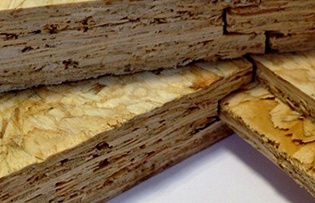 Mike Harrison, Marketing Manager, Coillte Panel Products
Mike Harrison, Marketing Manager, Coillte Panel ProductsWikiHouse is an open source building system which means that many design minds have come together to create it, forgoing the normal intellectual property issues to offer a collaborative approach that is refreshingly different in construction. What is now a global WikiHouse movement is centred around building an online database of timber frame building designs, which developers or individuals can download for free. These can then be taken to a CNC precision digital cutting factory, of which there are many across the UK, to be produced.
The prototype UK WikiHouse project, WikiHouse 4.0 was built at the Building Centre in London in 2014 to a design by Arup and Alistair Parvin of Zero Zero Architects, with a frame made of SmartPly OSB3. It not only provided a model of a good quality, affordable house that can be quickly constructed with minimal training, but also showed that OSB was an ideal structural material. The sight of precision-cut OSB walls and floors raised the eyebrows of many in the industry who, despite the use of OSB within traditional timber frame construction methods, still harbour the assumption the material is only for hoardings and other temporary uses.
The Government has pledged to build 400,000 homes over the life of this Parliament and there is currently little sign of that being delivered. There needs to be alternative visionary on how this will happen and WikiHouse is one route that needs to be taken more seriously. As part of an affordable answer to the problem, OSB can provide a cost-effective construction solution which also has a credible sustainability story behind it, in the case of SmartPly OSB3 offering full FSC accreditation.
WikiHouse can reduce build costs by up to two-thirds which is why housing associations have begun to take a keen interest faced with a reduction in rent income as Right to Buy is extended. South Yorkshire Housing Association is one of the first to take it forward with a plan to build a pilot home in the village of Darnall, again to a design by Alastair Parvin. The housing association is looking to construct it for around £50,000.
There is a wider and even more acute global context that could see the WikiHouse to come into its own, as exemplified by a pioneering project by a group of students in Delaware, USA called WikiHouse FirstState. They are working to establish proof of concept for applying the model to create sustainable, locally manufactured permanent shelters for disaster relief, and to help those in poverty such as displaced refugees. This is a particularly important development in the light of ongoing events in the Middle East, and the student group is taking an inspiring lead in showing how WikiHouse could help the 1 in 116 people worldwide that have had to flee their homes.
There are two big challenges in the UK however which remain in terms of widespread adoption of WikiHouse by individual homeowners, and the first is getting the land. If we are looking at people choosing the method due to its affordability this demographic may struggle to find the land to build on in many areas. Secondly there is the issue of convincing planners that a ‘cheap’ house is the right vernacular for a particular location. However, it is to be hoped that the many worthy benefits of WikiHouse, including its ability to provide appropriately styled homes, will begin to change attitudes.
Enlightened users have long recognised the structural performance capabilities of OSB in wall sheathing, flooring and roofing applications, yet wider general perception still regards OSB largely as a material for packaging, hoardings and other temporary functions. However, the WikiHouse initiative has demonstrated the versatility of OSB as one of the main structural material options for creating affordable low energy houses of the future. The more fundamental impact of this important movement is bringing democracy to housebuilding, opening the doors to delivery to everyone.

